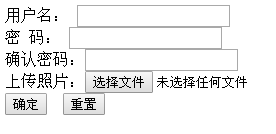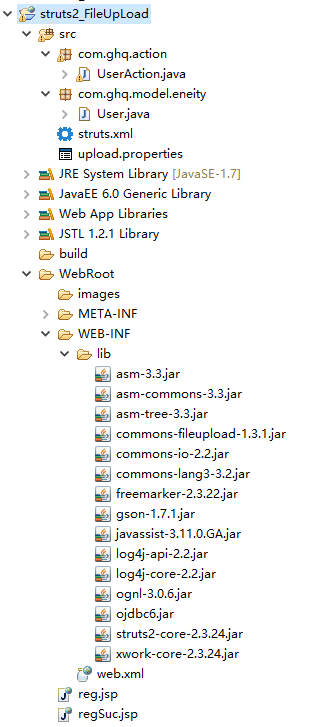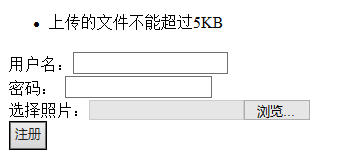文件下载(Servlet/Struts2)的链接:http://www.cnblogs.com/ghq120/p/8328093.html
文件上传
Servlet实现
要实现文件上传的功能,必须在form的表单中的添加 enctype="multipart/form-data" 表示以二进制流的方式将文件传给控制器。
需要导入的jar包有:commons-fileupload-1.2.1.jar、commons-io-1.4.jar
文件上传的步骤:
(1)创建DiskFileItemFactory的对象。
(2)创建ServletFileUpload的对象,需传入DiskFileItemFactory的对象。可以获得封装普通表单域和文件域的集合。
(3)创建存放新文件的名字;获取文件存放在服务器上的目录。
(4)对请求对象进行解析,获得一个封装的FileItem的集合,FileItem带表普通表单域或者文件域
(5)判断FileItem是普通表单域还是文本域;
若是普通表单域,则将普通表单域中的name和value封装到Map集合中。
若是文本域,获取被上传文件的名字并拼接上新的名字。创建文件上传的输入流。
(6)根据提供的目录和文件,创建一个File对象,表示的是目标文件。创建目标文件的输出流,表示将文件输出到服务器上。
(7)开始上传文件;读入被上传的文件,写入到目标文件。
(8)关闭输入和输出流。
项目的目录结构
index.jsp
UserServlet.java
package com.ghq.controller;
import java.io.File;
import java.io.FileOutputStream;
import java.io.IOException;
import java.io.InputStream;
import java.io.OutputStream;
import java.text.DateFormat;
import java.text.SimpleDateFormat;
import java.util.Date;
import java.util.HashMap;
import java.util.List;
import java.util.Map;
import java.util.Random;
import javax.servlet.ServletException;
import javax.servlet.http.HttpServlet;
import javax.servlet.http.HttpServletRequest;
import javax.servlet.http.HttpServletResponse;
import org.apache.commons.fileupload.FileItem;
import org.apache.commons.fileupload.FileUploadException;
import org.apache.commons.fileupload.disk.DiskFileItemFactory;
import org.apache.commons.fileupload.servlet.ServletFileUpload;
public class UserServlet extends HttpServlet {
public void doGet(HttpServletRequest request, HttpServletResponse response)
throws ServletException, IOException {
this.doPost(request, response);
}
public void doPost(HttpServletRequest request, HttpServletResponse response)
throws ServletException, IOException {
//创建DiskFileItemFactory的对象
DiskFileItemFactory fileItemFactory = new DiskFileItemFactory();
//创建ServletFileUpload的对象,可以获得封装普通表单域和文件域的集合
ServletFileUpload fileUpload = new ServletFileUpload(fileItemFactory);
//用于封装普通表单域的名字和表单域的内容
Map fieldMap = new HashMap();
//定义一个指定的时间格式器,
DateFormat dateFormat = new SimpleDateFormat("yyyyMMddHHmmssSSS");
//获取当前上传的时间
String currenTime = dateFormat.format(new Date());
//随机数生成器
Random ran = new Random();
//获取3位随机数
int randomNum = ran.nextInt(900)+100;
//用于存放新文件的名字,即当前时间字符串形式+3位的随机数
String newFileName = currenTime + randomNum;
//用于存放被上传文件对应的输入流
InputStream fin = null;
//用于存放目标文件的输出流,该文件将被产生在服务器上
OutputStream fout = null;
//用于获取images目录在服务器上的目录
String imageRealPath = this.getServletContext().getRealPath("/images");
byte[] source = new byte[1024];
//用于存放实际读取的字节个数
int count = 0;
try {
//对请求进行解析,获得一个封装的FileItem的集合,FileItem带表普通表单域或者文件域
List fileItems = fileUpload.parseRequest(request);
for(FileItem fi : fileItems){
//isFormField方法为true,FileItem对象代表普通表单域,否则是文件域
if (fi.isFormField()) {
//普通表单域的内容
String fieldValue = fi.getString();
//获取表单域的名字
String fieldName = fi.getFieldName();
//将指定的普通表单域的名字和内容封装到Map集合中
fieldMap.put(fieldName, fieldValue);
System.out.println(fieldName+" "+fieldValue);
}else {
//代表文件域,获取被上传文件的名字
String oldFileName = fi.getName();
//设置上传文件名的编码格式
oldFileName = new String(oldFileName.getBytes(),"utf-8");
newFileName += oldFileName;
fin = fi.getInputStream();
}
}
//根据提供的目录和文件,创建一个File对象,是目标文件
File targetFile = new File(imageRealPath,newFileName);
//服务器上不存在的文件对应的输出流,该文件就代表上传到服务器上的文件
fout = new FileOutputStream(targetFile);
//如果没有读到流的末尾则count不是-1
while ((count = fin.read(source)) != -1) {
//将读到的数据写到输出流中,不建议使用write(source)避免在最后的时候写入无效的数据
fout.write(source, 0, count);
}
} catch (FileUploadException e) {
e.printStackTrace();
} finally{
//关闭输出输入流
if (fout != null) {
fout.close();
}
if (fin != null) {
fin.close();
}
}
}
}
web.xml中的配置
xml version="1.0" encoding="UTF-8"?>
<web-app xmlns:xsi="http://www.w3.org/2001/XMLSchema-instance" xmlns="http://java.sun.com/xml/ns/javaee" xmlns:web="http://java.sun.com/xml/ns/javaee/web-app_2_5.xsd" xsi:schemaLocation="http://java.sun.com/xml/ns/javaee http://java.sun.com/xml/ns/javaee/web-app_3_0.xsd" id="WebApp_ID" version="3.0">
<servlet>
<servlet-name>UserServletservlet-name>
<servlet-class>com.ghq.controller.UserServletservlet-class>
servlet>
<servlet-mapping>
<servlet-name>UserServletservlet-name>
<url-pattern>/UserServleturl-pattern>
servlet-mapping>
web-app>
上传文件后,在服务器的地址下的效果如下:
Struts2 文件上传
项目目录结构
UserAction.java
package com.ghq.action;
import java.io.File;
import java.io.FileInputStream;
import java.io.FileOutputStream;
import java.util.UUID;
import org.apache.struts2.ServletActionContext;
import com.opensymphony.xwork2.ActionSupport;
public class UserAction extends ActionSupport {
private String username;
private String userpass;
//用于封装上传的对象,userphoto必须和文件域的名字相同 ,不管上传的文件类型是什么,userphoto扩展名都是tmp
private File userphoto;
//封装被上传的文件的名字,userphoto必须和文件域的名字相同,FileName区分大小写
private String userphotoFileName;
public String getUsername() {
return username;
}
public void setUsername(String username) {
this.username = username;
}
public String getUserpass() {
return userpass;
}
public void setUserpass(String userpass) {
this.userpass = userpass;
}
public File getUserphoto() {
return userphoto;
}
public void setUserphoto(File userphoto) {
this.userphoto = userphoto;
}
public String getUserphotoFileName() {
return userphotoFileName;
}
public void setUserphotoFileName(String userphotoFileName) {
this.userphotoFileName = userphotoFileName;
}
public String regUI() throws Exception{
return "regUI";
}
public String reg() throws Exception {
//获取目标文件所在目录的绝对路径
String filePath = ServletActionContext.getServletContext().getRealPath("/images");
//目标文件的名字 UUID和扩展名组成
String fileName = UUID.randomUUID().toString()+
userphotoFileName.substring(userphotoFileName.lastIndexOf("."));
//定义目标文件的对象,即要在服务器上出现的文件,要考虑到目标文件不能重复。
File targetFile = new File(filePath,fileName);
//获取上传文件的输入流
FileInputStream fin = new FileInputStream(userphoto);
//获取目标文件的输出流
FileOutputStream fout = new FileOutputStream(targetFile);
byte[] bs = new byte[1024];
int count = 0;
//上传文件
while ((count = fin.read(bs))!= -1) {
fout.write(bs,0,count);
}
if (fout != null) {
fout.close();
}
if (fin != null) {
fin.close();
}
return "regSuc";
}
}
注:使用common-io.jar包中的FileUtils类可以简化文件上传。
public String reg() throws Exception {
String filePath = ServletActionContext.getServletContext().getRealPath("/images");
String fileName = UUID.randomUUID().toString() + userphotoFileName.substring(userphotoFileName.lastIndexOf("."));
File targetFile = new File(filePath,fileName);
FileUtils.copyFile(userphoto,targetFile);
return "regSuc";
}
User.java
package com.ghq.model.eneity;
public class User {
private int id;
private String username;
private String userpass;
private String userphoto;
public User(int id, String username, String userpass, String userphoto) {
super();
this.id = id;
this.username = username;
this.userpass = userpass;
this.userphoto = userphoto;
}
//省略setter和getter方法
}
struts.xml配置
xml version="1.0" encoding="UTF-8" ?>
DOCTYPE struts PUBLIC
"-//Apache Software Foundation//DTD Struts Configuration 2.3//EN"
"http://struts.apache.org/dtds/struts-2.3.dtd">
<struts>
<constant name="struts.enable.DynamicMethodInvocation" value="false"/>
<constant name="struts.devMode" value="true"/>
<constant name="struts.action.extension" value="action"/>
<constant name="struts.custom.i18n.resources" value="upload"/>
<package name="user" extends="struts-default">
<global-results>
<result name="input">/reg.jspresult>
global-results>
<action name="UserAction_*" class="com.ghq.action.UserAction" method="{1}">
<result name="regSuc">/regSuc.jspresult>
<result name="regUI">/reg.jspresult>
<interceptor-ref name="fileUpload">
<param name="allowedExtensions">jpg,gif,jpeg,bmp,pngparam>
<param name="maximumSize">5210param>
interceptor-ref>
<interceptor-ref name="defaultStack">interceptor-ref>
action>
package>
struts>
reg.jsp
拦截器实现文件过滤
Struts2提供了一个文件上传的拦截器,通过配置拦截器可以轻松地实现文件过滤。在
<interceptor-ref name="fileUpload">
<param name="allowedExtensions">jpg,gif,jpeg,bmp,pngparam>
<param name="maximumSize">5210param>
interceptor-ref>
— 配置系统默认的拦截器 -->
<interceptor-ref name="defaultStack">interceptor-ref>
参数含义:
allowedExtensions:指定允许上传的文件类型,多个类型之前逗号隔开
maximumSize:指定允许上传的文件大小,单位是字节
可以在jsp页面中添加Struts2标签来输出错误信息,但是直接调用含有Struts2标签的jsp文件时,会发生如下异常
The Struts dispatcher cannot be found. This is usually caused by using Struts tags without the associated filter. Struts tags are only usable when the request has passed through its servlet filter, which initializes the Struts dispatcher needed for this tag.
解决办法:
利用逻辑视图和物理视图之间的对应关系,使用逻辑视图来调用物理视图。
例如上面的UserAction中的regUI方法就是实现了此功能,地址栏输入http://127.0.0.1:8080/struts2_FileUpLoad/UserAction_regUI.action,调用regUI方法,返回"regUI",在struts.xml文件中找到对应的物理视图映射reg.jsp来加载页面。
错误信息正常显示的是英文提示,用户体检不佳
可以使用国际化信息替换。编写upload.properties文件
在struts.xml文件中配置以加载此文件
<constant name="struts.custom.i18n.resources" value="upload"/>
配置后显示样式为
SpringMVC 多文件上传
同样文件上传需要导入的包是:commons-fileupload-1.2.1.jar、commons-io-1.4.jar
SpringMVC的文件上传使用了注解
类
@Controller 指定当前类是处理器 Spring注解
@RequestMapping 指定处理器url前缀 SpringMVC注解
方法
@RequestMapping 处理url后缀
参数
@RequestParam 方法的参数,接收请求参数值
项目目录结构
web.xml配置
xml version="1.0" encoding="UTF-8"?>
<web-app xmlns:xsi="http://www.w3.org/2001/XMLSchema-instance" xmlns="http://java.sun.com/xml/ns/javaee" xmlns:web="http://java.sun.com/xml/ns/javaee/web-app_2_5.xsd" xsi:schemaLocation="http://java.sun.com/xml/ns/javaee http://java.sun.com/xml/ns/javaee/web-app_3_0.xsd" id="WebApp_ID" version="3.0">
<servlet>
<servlet-name>springmvcservlet-name>
<servlet-class>org.springframework.web.servlet.DispatcherServletservlet-class>
<load-on-startup>1load-on-startup>
servlet>
<servlet-mapping>
<servlet-name>springmvcservlet-name>
<url-pattern>*.dourl-pattern>
servlet-mapping>
<filter>
<filter-name>characterEncodingfilter-name>
<filter-class>org.springframework.web.filter.CharacterEncodingFilterfilter-class>
<init-param>
<param-name>encodingparam-name>
<param-value>utf-8param-value>
init-param>
filter>
<filter-mapping>
<filter-name>characterEncodingfilter-name>
<url-pattern>/*url-pattern>
filter-mapping>
<welcome-file-list>
<welcome-file>login/index.jspwelcome-file>
welcome-file-list>
web-app>
myFileUpload.java
package com.ghq.controller;
import java.io.File;
import java.util.UUID;
import javax.servlet.http.HttpServletRequest;
import org.springframework.stereotype.Controller;
import org.springframework.web.bind.annotation.RequestMapping;
import org.springframework.web.bind.annotation.RequestParam;
import org.springframework.web.multipart.MultipartFile;
@Controller
@RequestMapping("/user")
public class myFileUpLoad{
@RequestMapping("/fileupload")
public String fileupload(HttpServletRequest request,@RequestParam MultipartFile[] files) throws Exception {
if (files != null && files.length > 0) {
for (int i = 0; i < files.length; i++) {
//获取原始文件名
String orifName = files[i].getOriginalFilename();
//获取扩展名
String extName = orifName.substring(orifName.lastIndexOf("."));
//获得服务器上的虚拟路径
String filePath = request.getServletContext().getRealPath("/images");
//创建目标文件
File targetfile = new File(filePath, UUID.randomUUID()+extName);
//文件上传
files[i].transferTo(targetfile);
}
}
return "success";
}
}
SpringMVC中的文件大小和类型过滤都分别需要定义一个新的类
文件大小的限制
package com.ghq.util;
import javax.servlet.http.HttpServletRequest;
import javax.servlet.http.HttpServletResponse;
import org.springframework.web.multipart.MaxUploadSizeExceededException;
import org.springframework.web.servlet.HandlerExceptionResolver;
import org.springframework.web.servlet.ModelAndView;
//自定义一个异常解析器,捕获MaxUploadSizeExceededException异常
public class FileSizeDeal implements HandlerExceptionResolver{
@Override
public ModelAndView resolveException(HttpServletRequest request,
HttpServletResponse response, Object obj, Exception e) {
ModelAndView mv = new ModelAndView();
if (e instanceof MaxUploadSizeExceededException) {
mv.addObject("msg", "上传的文件大小不能超过100K");
mv.setViewName("index");
return mv;
}
return null;
}
}
文件类型的限制
package com.ghq.util;
import java.util.Map;
import java.util.Set;
import javax.servlet.http.HttpServletRequest;
import javax.servlet.http.HttpServletResponse;
import org.springframework.web.multipart.MultipartFile;
import org.springframework.web.multipart.MultipartHttpServletRequest;
import org.springframework.web.servlet.handler.HandlerInterceptorAdapter;
//开发拦截器,用于对文件类型进行过滤
public class FileTypeInterceptro extends HandlerInterceptorAdapter{
@Override
public boolean preHandle(HttpServletRequest request,
HttpServletResponse response, Object handler) throws Exception {
boolean flag = true;
//判断拦截的请求是上传请求
if (request instanceof MultipartHttpServletRequest) {
MultipartHttpServletRequest mulReq = (MultipartHttpServletRequest)request;
//获得所有的上传文件
Map maps = mulReq.getFileMap();
//获得map中键的集合
Set keySet = maps.keySet();
MultipartFile mulFile = null;
for (String key : keySet) {
//根据键获得文件
mulFile = mulReq.getFile(key);
//获得文件的名字
String oriFName = mulFile.getOriginalFilename();
//若没有上传文件则转到上传页面
if (oriFName.equals("")||oriFName == null) {
request.setAttribute("msg", "请选择要上传的图片");
request.getRequestDispatcher("/login/index.jsp").forward(request, response);
return flag;
}
//判断上传文件的后缀是否是规定的类型
flag = isValid(oriFName);
if (!flag) {
request.setAttribute("msg", "只能上传图片");
request.getRequestDispatcher("/login/index.jsp").forward(request, response);
return flag;
}
}
}
return flag;
}
public boolean isValid(String oriFName){
String allowedExts = "jpg,jpeg,gif,png,bmp";
String extName = oriFName.substring(oriFName.lastIndexOf(".")+1);
if (allowedExts.contains(extName)) {
return true;
}
return false;
}
}
Spring配置文件中的配置
xml version="1.0" encoding="UTF-8"?>
<beans xmlns="http://www.springframework.org/schema/beans"
xmlns:xsi="http://www.w3.org/2001/XMLSchema-instance"
xmlns:context="http://www.springframework.org/schema/context"
xmlns:mvc="http://www.springframework.org/schema/mvc"
xsi:schemaLocation="
http://www.springframework.org/schema/beans
http://www.springframework.org/schema/beans/spring-beans.xsd
http://www.springframework.org/schema/context
http://www.springframework.org/schema/context/spring-context.xsd
http://www.springframework.org/schema/mvc
http://www.springframework.org/schema/mvc/spring-mvc.xsd
">
<context:component-scan base-package="com.ghq.controller">context:component-scan>
<mvc:annotation-driven>mvc:annotation-driven>
<bean id="resourceViewResolver" class="org.springframework.web.servlet.view.InternalResourceViewResolver">
<property name="viewClass" value="org.springframework.web.servlet.view.JstlView"/>
<property name="prefix" value="/login/"/>
<property name="suffix" value=".jsp"/>
bean>
<bean id="multipartResolver" class="org.springframework.web.multipart.commons.CommonsMultipartResolver">
<property name="maxUploadSize" value="102400">property>
bean>
<bean id="sizeDeal" class="com.ghq.util.FileSizeDeal">bean>
<mvc:interceptors>
<mvc:interceptor>
<mvc:mapping path="/**"/>
<bean class="com.ghq.util.FileTypeInterceptro"/>
mvc:interceptor>
mvc:interceptors>
beans>
jsp页面
<body>
${msg }
<form action="<%=path %>/user/fileupload.do" method="post" enctype="multipart/form-data">
<input type="file" name="files"><br>
<input type="file" name="files"><br>
<input type="submit" value="上传">
form>
body>







